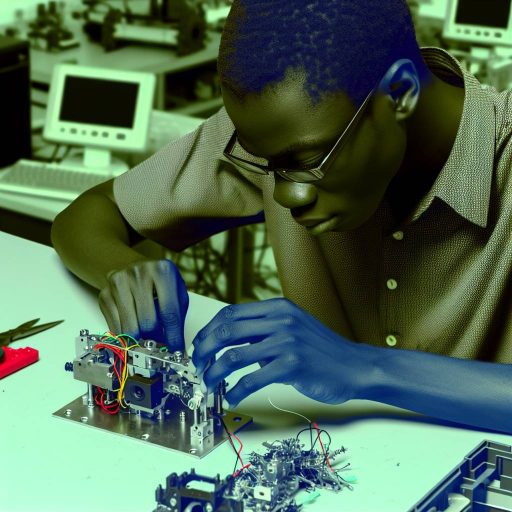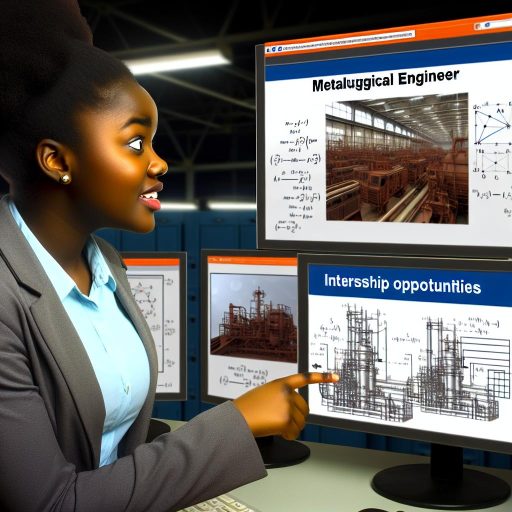Introduction
Mechatronics is a field that combines mechanical, electrical, and computer engineering to design technologies in various industries.
It plays a crucial role in automation, robotics, and advanced manufacturing.
The components of mechatronics include sensors, actuators, control systems, and microprocessors.
These elements work together to create intelligent systems that can perform specific tasks efficiently and accurately.
Government Regulations on Education
Overview of government policies affecting the education and training of Mechatronics professionals.
Analysis of the impact of these regulations on the quality of Mechatronics education.
Introduction
Government regulations play a crucial role in shaping the education and training of Mechatronics professionals.
These policies outline the standards, requirements, and guidelines that institutions offering Mechatronics programs must adhere to.
By examining the impact of government regulations on the field of Mechatronics education, we can gain valuable insights into how these policies shape the quality and caliber of professionals entering the industry.
Government Policies and Their Impact
Curriculum Development
One of the key aspects of government regulations on Mechatronics education is the development of the curriculum.
These policies define the core subjects, practical components, and hands-on training required for students pursuing a career in Mechatronics.
By setting standards for the curriculum, government regulations ensure that students receive a comprehensive education that prepares them for the demands of the industry.
Accreditation and Certification
Government regulations also play a crucial role in accrediting institutions offering Mechatronics programs and certifying graduates.
Accreditation ensures that institutions meet certain quality standards, while certification verifies that graduates have attained the necessary skills and knowledge to work in the field.
These regulations help maintain the credibility and reputation of Mechatronics programs, ensuring that students receive a high-quality education.
Industry Partnerships
Government policies often encourage collaboration between educational institutions and industry partners in the field of Mechatronics.
By fostering partnerships with industry leaders, institutions can provide students with valuable hands-on experience, access to cutting-edge technology, and networking opportunities.
These partnerships help bridge the gap between academic theory and practical application, better preparing students for the workforce.
Quality of Mechatronics Education
Government regulations have a significant impact on the quality of Mechatronics education.
By setting standards for curriculum development, accreditation, and industry partnerships, these policies ensure that students receive a well-rounded education that equips them with the skills and knowledge needed to succeed in the field.
As a result, graduates of Mechatronics programs are prepared to meet the demands of a rapidly evolving industry, contributing to innovation and technological advancement.
Future Directions in Mechatronics Education
Government regulations play a crucial role in shaping the education and training of Mechatronics professionals.
By outlining standards for curriculum development, accreditation, and industry partnerships, these policies ensure that students receive a high-quality education that prepares them for successful careers in the field.
As the field of Mechatronics continues to grow and evolve, government regulations will play an ever-increasing role in shaping the future of the industry.
Funding and Support for Research and Development
Government funding and support play a crucial role in driving innovation and advancement in the field of Mechatronics.
Without adequate resources, researchers and developers may struggle to push the boundaries of technology and bring new ideas to life.
Discussion on Government Funding and Support
Government funding for research and development in Mechatronics typically comes in the form of grants, contracts, and partnerships with academic institutions and private companies.
These funds are essential for conducting experiments, building prototypes, and testing new technologies.
Support from government agencies can also help foster collaboration between different stakeholders in the Mechatronics industry.
By providing a platform for researchers, manufacturers, and policymakers to work together, governments can facilitate the exchange of ideas and promote innovation.
Furthermore, government support can elevate the visibility and credibility of Mechatronics projects, attracting additional investments from the private sector.
This, in turn, can fuel further research and development efforts, leading to the creation of cutting-edge technologies and solutions.
Examples of Successful Government Initiatives
- National Robotics Initiative (NRI): The NRI, launched by the U.S. government, aims to accelerate the development and deployment of robotics technologies across various sectors, including healthcare, manufacturing, and defense. By funding interdisciplinary research projects, the NRI has contributed to significant advancements in Mechatronics.
- European Union Horizon 2020: Horizon 2020 is the largest EU research and innovation program, with a budget of €80 billion. Through funding opportunities like the European Institute of Innovation and Technology (EIT) Digital, the EU has supported Mechatronics projects that focus on digital transformation, sustainable development, and smart manufacturing.
- Japan’s Society 5.0 Initiative: In response to the Fourth Industrial Revolution, Japan has launched the Society 5.0 initiative, which envisions a human-centered society where technology enhances quality of life. By investing in research areas such as artificial intelligence, IoT, and robotics, the Japanese government is driving innovations in Mechatronics that benefit society as a whole.
These examples highlight the impact of government policies on the Mechatronics field.
By providing funding and support for research and development, governments can catalyze technological breakthroughs and pave the way for a more connected and automated future.
See Related Content: Top Mechatronics Engineering Firms in Nigeria
Tax Incentives for Mechatronics Industry
Government policies play a crucial role in shaping the growth and development of various industries, including mechatronics.
One of the key tools utilized by governments around the world to promote investment in the mechatronics sector is the provision of tax incentives.
Tax incentives are essentially benefits provided by the government to encourage businesses and individuals to engage in specific activities, such as investing in new technology or infrastructure.
In the case of the mechatronics industry, tax incentives can take various forms, such as tax credits, deductions, exemptions, or deferrals.
Explanation of Tax Incentives
- Tax Credits: These are direct reductions in the amount of taxes owed by a business or individual. For example, a mechatronics company may be eligible for a tax credit for investing in research and development of new mechatronic products or technologies.
- Deductions: Deductions allow businesses to reduce their taxable income by subtracting certain expenses from their revenue. This could include expenses related to the purchase of mechatronics equipment or machinery.
- Exemptions: Exemptions relieve businesses from having to pay taxes on specific types of income or transactions. In the mechatronics industry, businesses may be exempt from certain taxes on income generated from exporting mechatronic products.
- Deferrals: Deferrals allow businesses to postpone paying taxes on income earned from certain activities. This can provide mechatronics companies with more cash flow to reinvest in their operations or expansion.
Assessment of Effectiveness
The effectiveness of tax incentives in incentivizing investment in the mechatronics industry can be evaluated based on several factors.
Transform Your Career with Expert Guidance
Get personalized mentorship consulting that’s tailored to your unique path. Our expert advice is actionable and exclusive.
Get StartedOne of the key considerations is whether these incentives are tailored to the specific needs and challenges faced by mechatronics companies.
For instance, tax credits for research and development can encourage innovation and technological advancement in the industry.
Furthermore, the ease of access and application process for tax incentives can also impact their effectiveness.
If the criteria for eligibility are too stringent or the process is overly complex, businesses may be deterred from taking advantage of these incentives.
Streamlining the application process and ensuring clear guidance on eligibility requirements can enhance the uptake of tax incentives by mechatronics companies.
Another crucial aspect to consider is the overall competitiveness of the mechatronics industry within the global market.
Tax incentives can influence the cost-effectiveness of doing business in a particular country or region.
Therefore, governments need to continuously review and update their tax incentive policies to ensure they remain relevant and competitive in attracting investment in mechatronics.
Additionally, the alignment of tax incentives with broader industrial policies and strategies can enhance their impact on the mechatronics industry.
For example, linking tax incentives for mechatronics companies with workforce development programs can help address skills shortages in the industry and create a more robust talent pool.
Learn More: History of Architecture in Nigeria: Key Milestones
Occupational Health and Safety Regulations
Government regulations play a crucial role in ensuring the safety and well-being of Mechatronics professionals in the workplace.
These regulations are put in place to protect workers from potential hazards and ensure a safe working environment for all individuals involved in the field.
Overview of Occupational Health and Safety Regulations
- These regulations cover a wide range of safety measures, including workplace conditions, equipment maintenance, and employee training.
- Occupational Health and Safety (OHS) regulations are designed to prevent accidents and injuries in the workplace.
- Employers are required to follow these regulations to protect their employees and minimize risks in the workplace.
- OHS regulations also include guidelines for handling hazardous materials, emergency protocols, and regular safety inspections.
Analysis of Impact on Mechatronics Workers
- Implementing OHS regulations positively impacts the overall well-being of workers in the Mechatronics field.
- By adhering to safety protocols, employers create a safer work environment that reduces the risk of accidents.
- Training programs help employees become aware of potential hazards and how to mitigate risks in their daily tasks.
- Regular safety inspections ensure that equipment is maintained properly and that workplace conditions meet safety standards.
It is evident that the strict enforcement of Occupational Health and Safety regulations in the Mechatronics field is essential for safeguarding the health and safety of workers.
By adhering to these regulations, employers not only protect their employees but also contribute to a more efficient and productive work environment.
Explore Further: Innovations in Nigerian Materials Engineering Education

When it comes to the field of Mechatronics, international trade policies play a significant role in shaping the import and export of equipment and technology.
These policies can have a direct impact on how businesses in this industry operate and thrive globally.
Effects of Government Trade Policies
-
Import Restrictions: Government policies that restrict imports of Mechatronics equipment can hinder the growth of the industry.
-
Export Opportunities: On the other hand, trade policies that promote exports can benefit Mechatronics businesses by opening up new markets and increasing demand for their products.
Case Studies on Tariffs and Trade Agreements
-
Tariffs Impact: A case study on how tariffs imposed on Mechatronics equipment can affect manufacturing costs and pricing strategies.
-
Trade Agreements: Analyzing the impact of trade agreements on the Mechatronics industry, such as free trade agreements that reduce barriers to market entry.
Government trade policies have a direct influence on the Mechatronics field.
It is crucial for policymakers to balance protectionism with promoting innovation and global competitiveness in order to support the growth of this dynamic industry.
Find Out More: Agricultural Engineering Internships: How to Find One
Government Policies Affecting Mechatronics Field
Government policies play a crucial role in influencing the development and growth of the mechatronics field.
Through funding initiatives, governments can support research and innovation in mechatronics technology.
Regulations set by governments can drive the adoption of mechatronics solutions in various industries.
Tax incentives for businesses investing in mechatronics can encourage advancements in this field.
Government partnerships with academic institutions can help in training a skilled workforce for the mechatronics sector.
Trade agreements can impact the import and export of mechatronics components and technology.
Environmental regulations may drive the development of sustainable mechatronics solutions.
Impact of Government Policies
Government policies have a significant impact on the trajectory of the mechatronics field.
By creating a supportive environment through funding, regulations, and incentives, governments can shape the future of mechatronics technology.
It is essential for policymakers to understand the potential of mechatronics and implement policies that foster innovation and growth in this field.
Additional Resources
Ethical implications of AI and robotics in healthcare: A review – PMC
Engineering for sustainable development: delivering on the …




